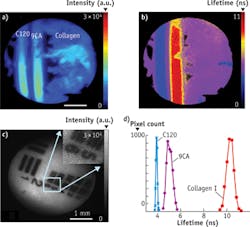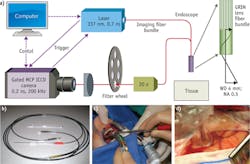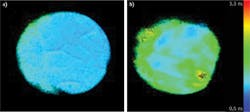FLUORESCENCE SPECTROSCOPY/BIOMEDICAL IMAGING: Fluorescence 'lifetime' moves toward clinical application
Fluorescence represents a ubiquitous means of achieving label-free optical molecular contrast—and the approach can be applied using a range of instruments, including spectrophotometers, microscopes, and endoscopes. Fluorescence measurements can provide information on the specific molecular features in biological tissues. Various pathological conditions and therapeutic intervention can lead to biochemical, functional, and structural transformations of endogenous fluorescent biomolecular complexes in tissue and cells, including structural proteins, enzyme metabolic co-factors, lipid and lipoproteins constituents, and porphyrins. Thus, such transformations carry diagnostic information. For these reasons, tissue autofluorescence has been increasingly explored over the past two decades as a tool for diagnosis of illnesses ranging from a variety of cancers to cardiovascular diseases.1,2
Clinical diagnostic applications of autofluorescence have been based mainly on steady-state fluorescence-an approach that uses relatively simple and inexpensive instruments. However, this technique relies on measurement of fluorescence emission intensity and/or spectra that are affected by numerous factors, including irregular tissue surfaces, non-uniform sample illumination, and the presence of endogenous absorbers such as blood in the operative field. An alternative method that addresses such limitations is based on time-resolved (lifetime) measurement of fluorescence emission. This technique can resolve excited-state lifetimes and improve the specificity of fluorescence measurements.3
Despite recognized advantages, the full potential value of time-resolved fluorescence spectroscopy and imaging has been only sparsely evaluated in clinical settings. Barriers to clinical translation include the complexity of the instrumental setups, lengthy data acquisition and analysis, and high instrumentation costs associated with these techniques.1 Recent advances in multispectral time-resolved fluorescence spectroscopy (ms-TRFS) technologies, however, may overcome such barriers and allow for development of versatile diagnostic systems that can operate as both point-spectroscopy and scanning imaging spectroscopy devices. In addition, development of endoscopic wide-field fluorescence lifetime imaging microscopy (FLIM) systems can add diagnostic value to existing endoscopic systems.
ms-TRFS for in vivo tissue diagnosis
Tissue fluorescence emission represents a superposition of many spectrally overlapping fluorescent molecules. The result is a variation of measured fluorescence lifetime with wavelength. Thus, for a more effective use of fluorescence lifetime(s) information, measurements of spectrally resolved fluorescence decay characteristics are required. This has been typically achieved through the use of either a scanning monochromator4 or a set of bandpass filters5 that can resolve a sample's emission spectrum sequentially before each spectral intensity is time-resolved. However, recording of fluorescence decays at multiple wavelengths is inherently associated with long data acquisition time-a fact that limits the applicability of this technique to point-static measurements.
New research has produced a solution for rapid and simultaneous recording of fluorescence decays in multiple spectral bands compatible with in vivo applications.6 In this configuration, the emission spectrum is resolved using a set of dichroic and bandpass filters, allowing for selection of four channels or wavelength bands (see Fig. 1). Each channel is coupled to optical fibers of distinct lengths that act as optical delay lines. Thus, the spectrally resolved fluorescence decays arrive at the detector separated in time (~50 ns).
This ms-TRFS device is based on pulse sampling and gated detection, and the detector remains on until it reads the entire fluorescence transient pulse. A digitizer with high sampling frequency and analog bandwidth (8 Gsamples/s, 3 GHz) records the pulse. If the sample has high quantum efficiency, a single excitation pulse is enough to simultaneously record a complete transient fluorescent pulse for each channel (wavelength band). This method allows fast recording of fluorescence decays (e.g., <1 μs per data point) in multiple spectral bands generated in response to a single excitation event. It also offers enhanced portability.
Importantly, this versatile system enables acquisition and analysis of fluorescence data in several operation modes. The same instrument can be used for point spectroscopy, for instance, and can also scan in line, planar (XY), and even with pull-back motion-rotational modes. The latter allows for recovery of spectroscopic or fluorescence lifetime imaging (FLIm), even in high spatial resolution. The spectral channels can be adapted to resolve the autofluorescence emission of key biomolecules in tissue, including collagen, elastin, nicotinamide adenine dinucleotide (NADH), lipopigments, flavins, and porphyrins.Wide-field FLIM enables endoscopy
Traditional white-light endoscopes, commonly used in a broad range of clinical applications, enable their operators to see inside the body—but are unable to characterize a tissue's molecular makeup based on its autofluorescence signatures. Adding this ability, however, would improve the diagnostic values of endoscopic procedures.What are the needs?
As discussed, time-resolved fluorescence spectroscopy and imaging systems achieve label-free optical molecular contrast in diseased tissues. And clinical studies conducted with instrumentation based on this principle show that fluorescence lifetime contrast carries diagnostic value. However, the total number of clinical studies using fluorescence lifetime technologies remains sparse.
The availability of a number of affordable components promises to facilitate further development of compact and practical ms-TRFS and FLIM systems. Among these are affordable sub-nanosecond pulsed UV laser light sources, fast-response and sensitive detectors, and new solutions for fast recording of spectrally resolved fluorescence lifetime information. Advancement of analytical methods for fast processing of the fluorescence intensity decay data is another possible enabler. Such solutions may spawn a new generation of practical devices for clinical research studies and systematic testing of their diagnostic potential.
REFERENCES
1. L. Marcu, Annals Biomed. Eng., 40, 2, 304-331 (2012).
2. R. Richards-Kortum and E. Sevick-Muraca, Annu. Rev. Phys. Chem., 47, 555-606 (1996).
3. J. R. Lakowicz, Principles of fluorescence spectroscopy, 3, Kluwer Academic/Plenum, New York (2006).
4. Q. Fang et al., Rev. Sci. Instrum., 75, 151-162 (2004).
5. Y. Sun et al., Opt Lett., 33, 6, 630-632 (2008).
6. D. R. Yankelevich et al., Rev. Sci. Instrum., 85, 3, 034303 (2014); doi:10.1063/1.4869037.
7. H. Fatakdawala et al., Biomed. Opt. Exp., 4, 9, 1724-1741 (2013).
8. D. Gorpas et al., "Bi-modal imaging of atherosclerotic plaques: Automated method for co-registration between fluorescence lifetime imaging and intravascular ultrasound data," Proc. SPIE, 8926, 892638 (2014).
9. Y. Sun et al., Microsc. Microanal., 19, 4, 791-798 (2013).
10. Y. Sun et al., J. Biomed. Opt., 15, 5, 056022 (2010).

Laura Marcu, Ph.D. | Professor of Biomedical Engineering and Neurological Surgery
Laura Marcu, Ph.D., is a Professor of Biomedical Engineering and Neurological Surgery at the University of California, Davis, and her work focuses primarily on research for development of optical techniques for tissue diagnostics. Her laboratory has developed time-resolved fluorescence spectroscopy (TRFS) and fluorescence lifetime imaging microscopy (FLIM) systems for in vivo tissue interrogation, including human patients. Her laboratory has a broad expertise in clinical translation of biophotonic technologies that play an important role in addressing challenges associate with tissue diagnostics and therapies.
Currently, Dr. Marcu holds a joint appointment as a Professor of Neurological Surgery in the School of Medicine. She serves as Co-leader of the Comprehensive Cancer Center Biomedical Technology Program, Domain Leader of the University of California Center for Accelerated Innovation, and Chair of the Designated Emphasis in Biophotonics and Bioimaging graduate program. She is a fellow of OSA, SPIE, the Biomedical Engineering Society (BMES), and the American Institute of Biomedical Engineering.






